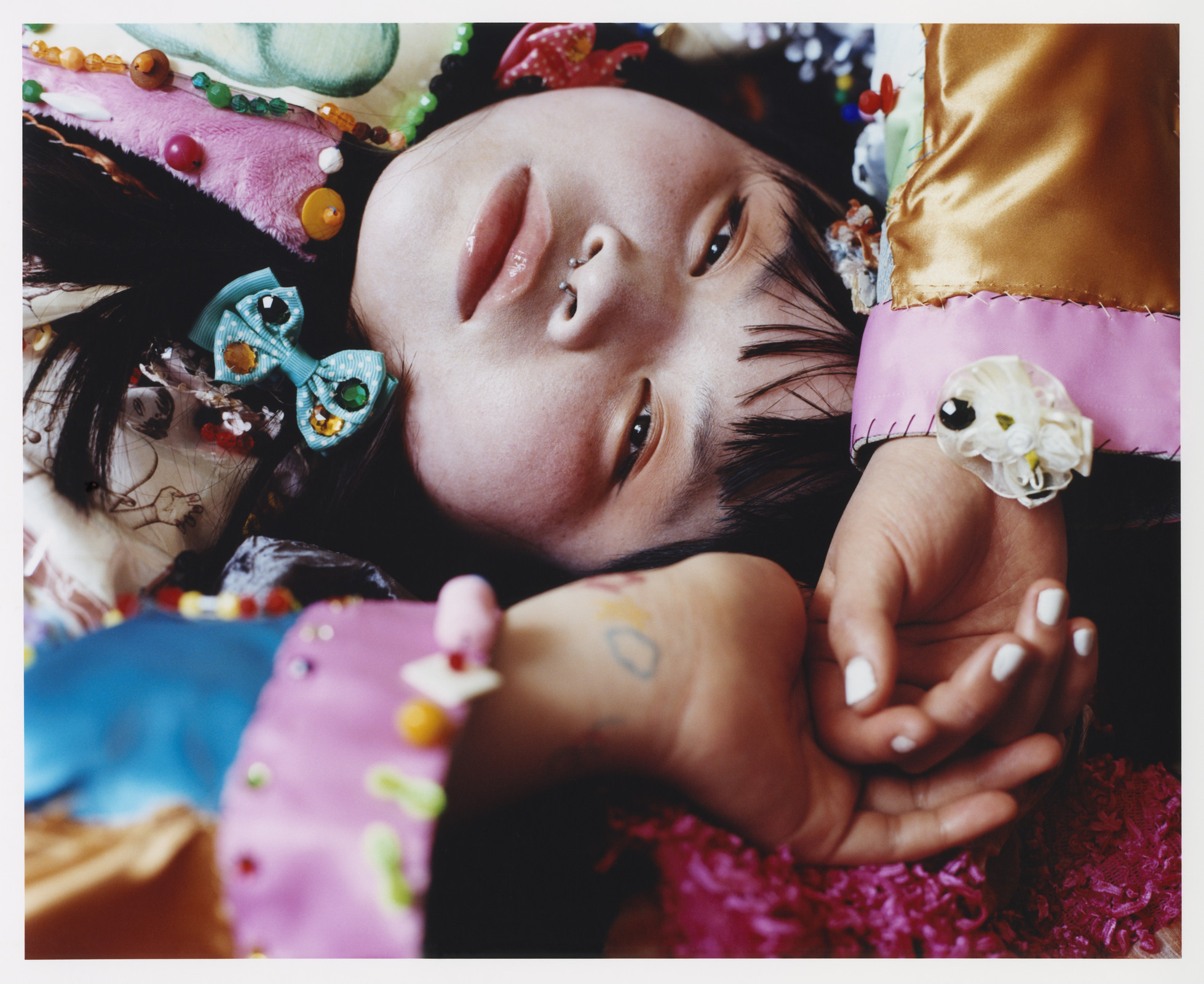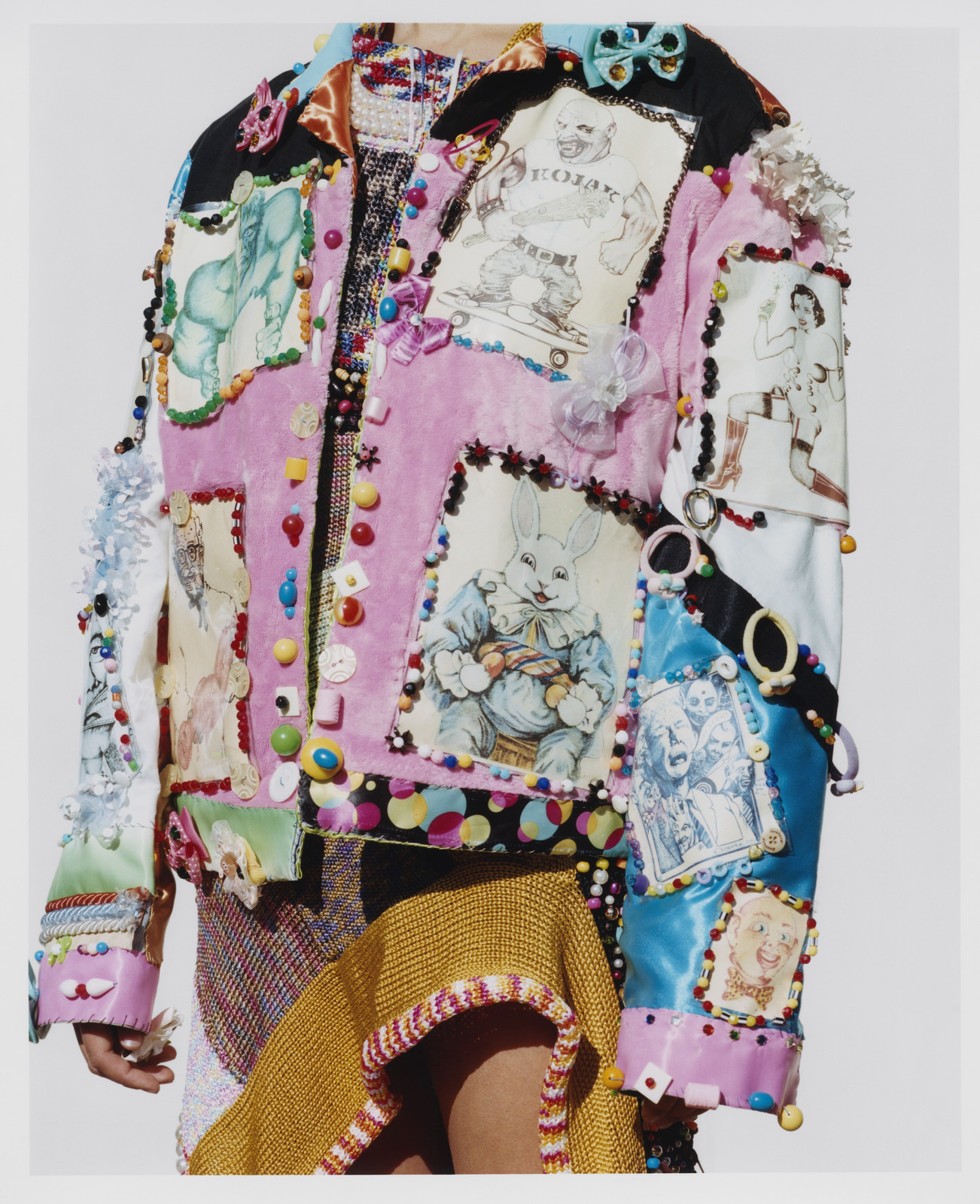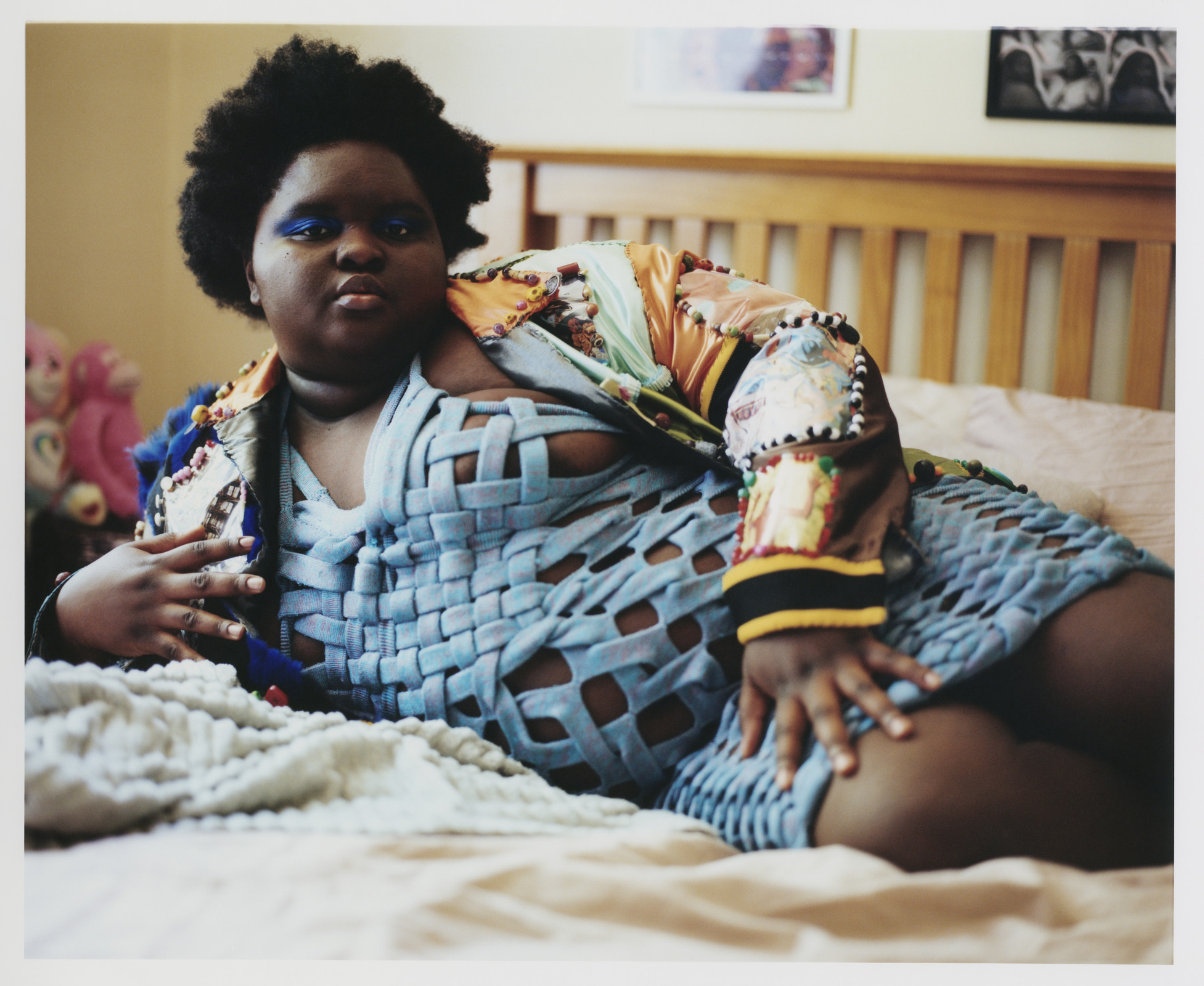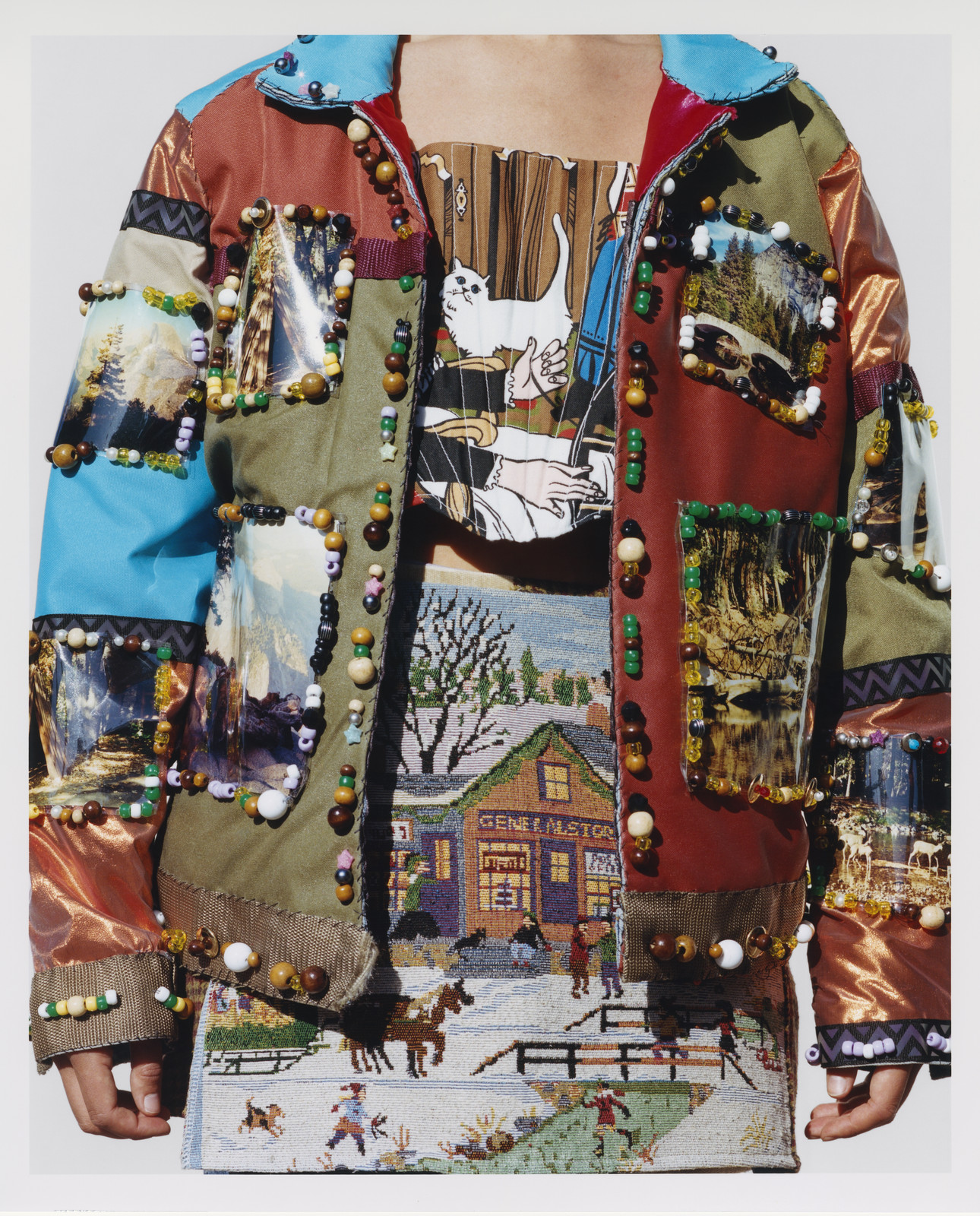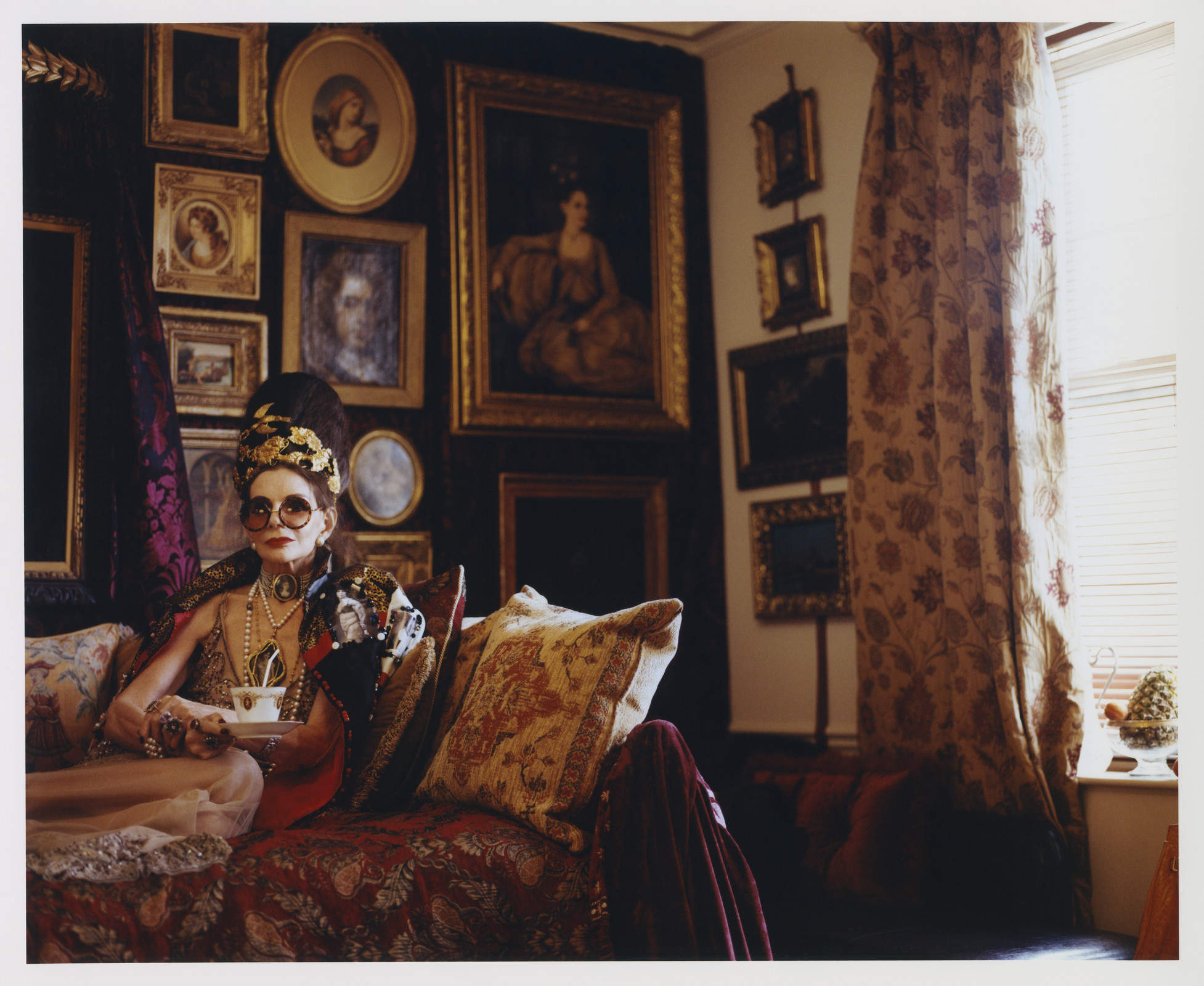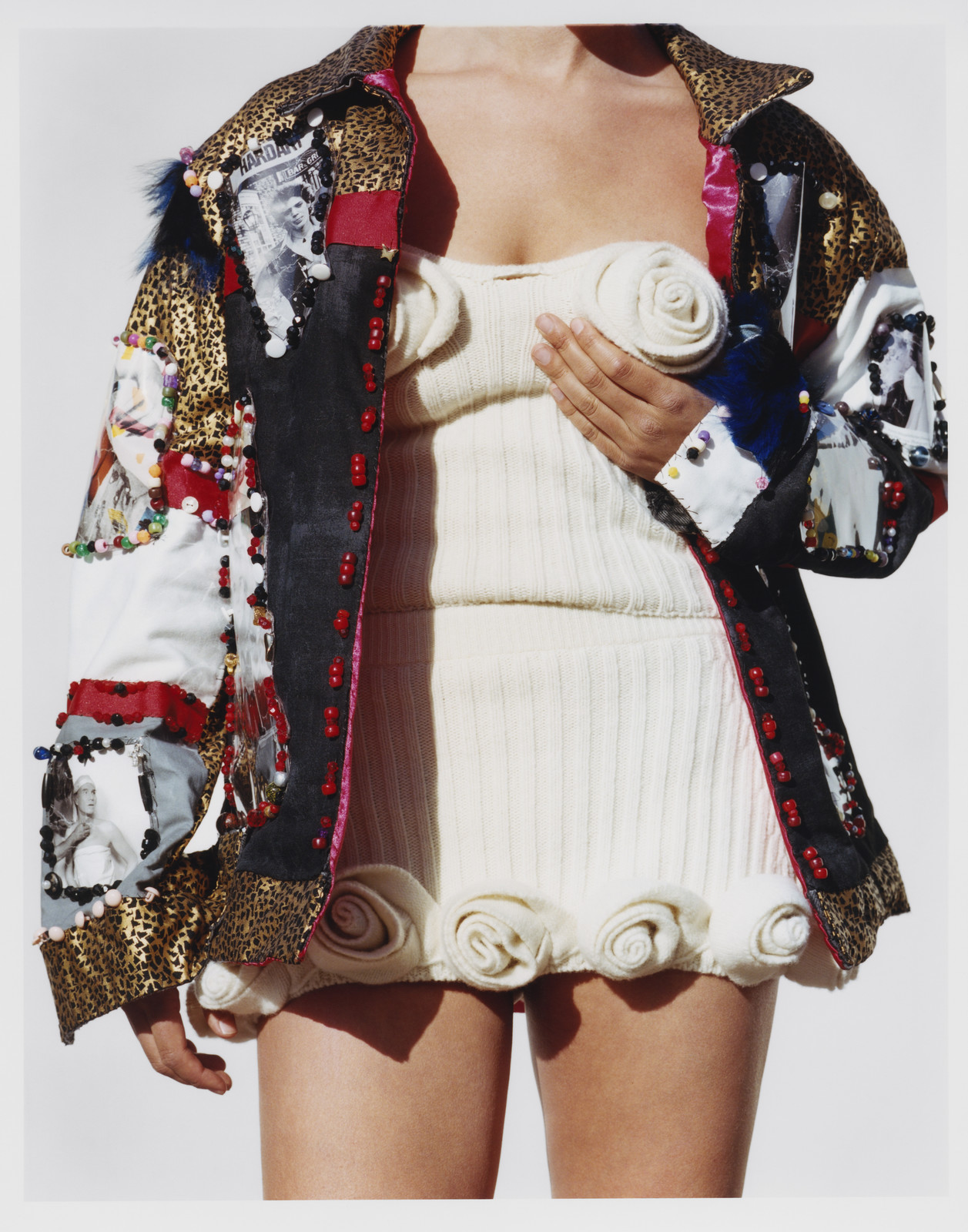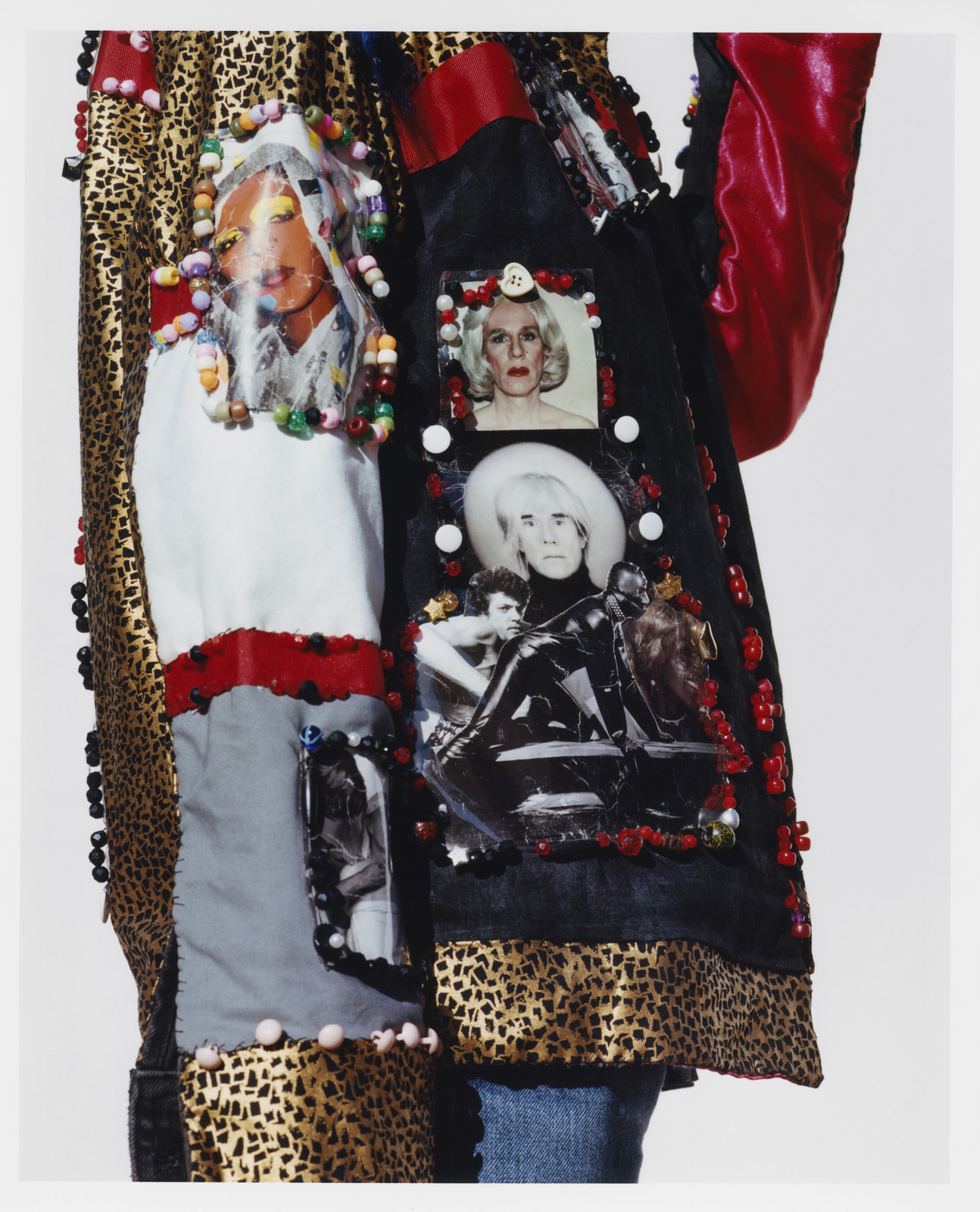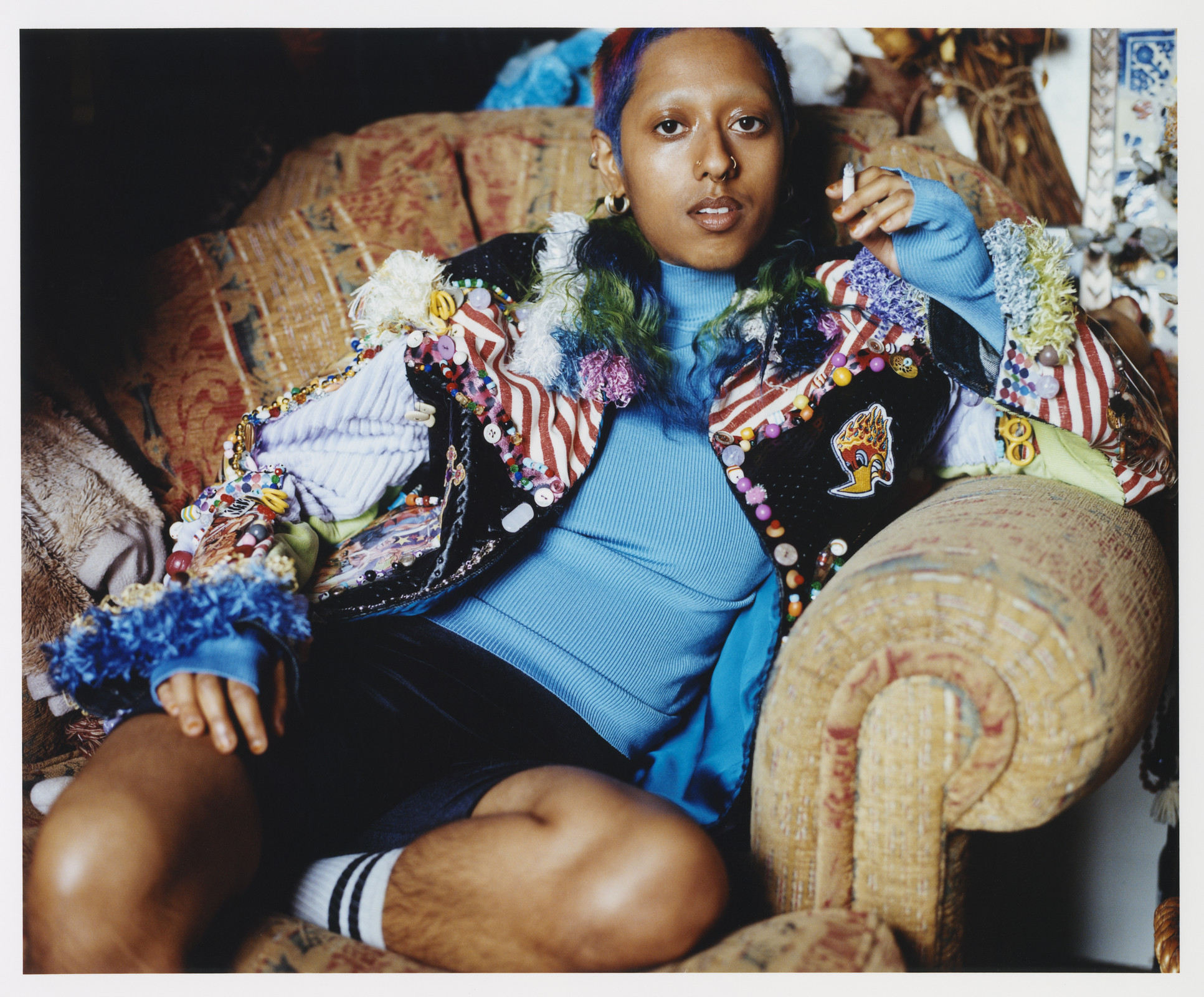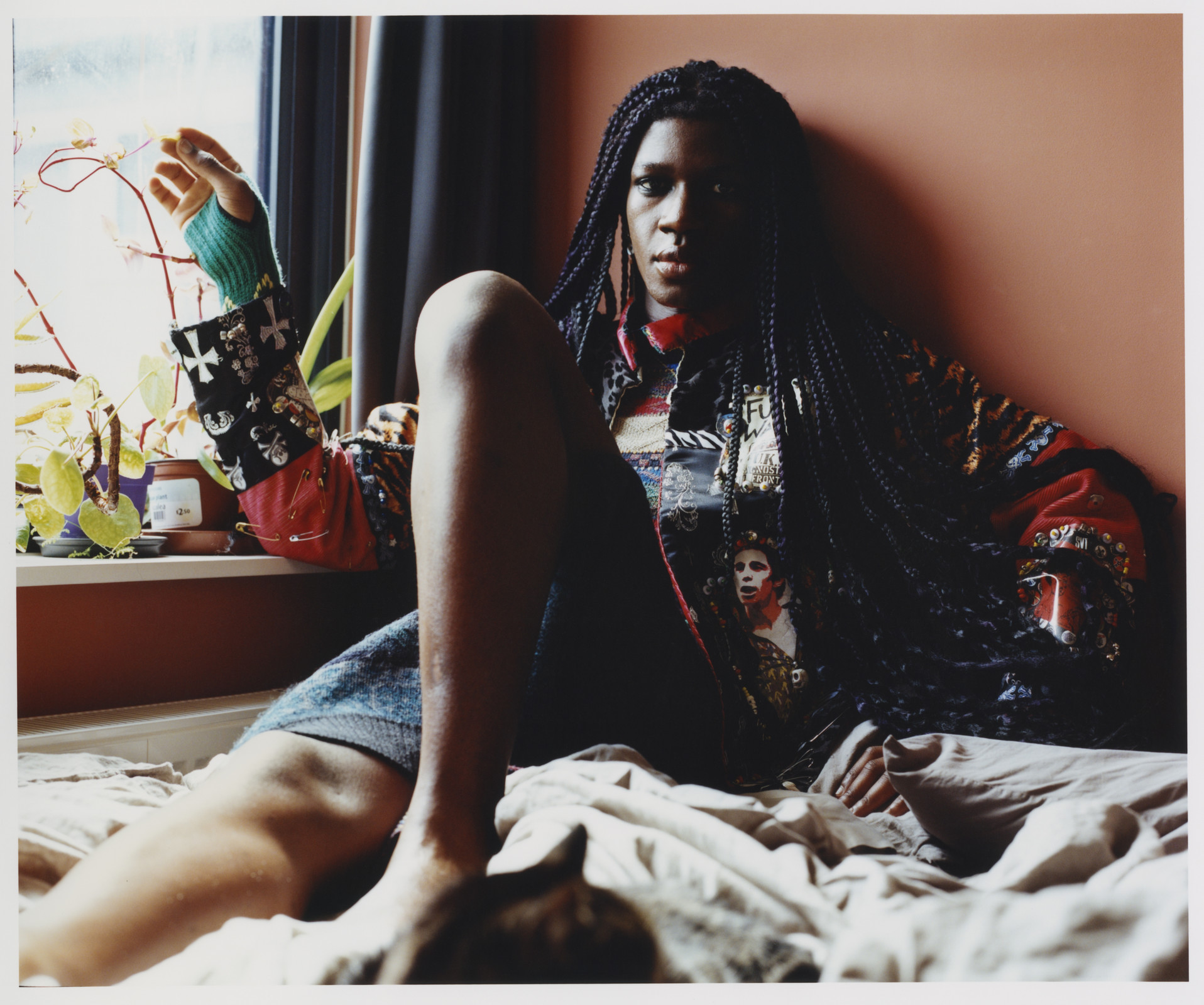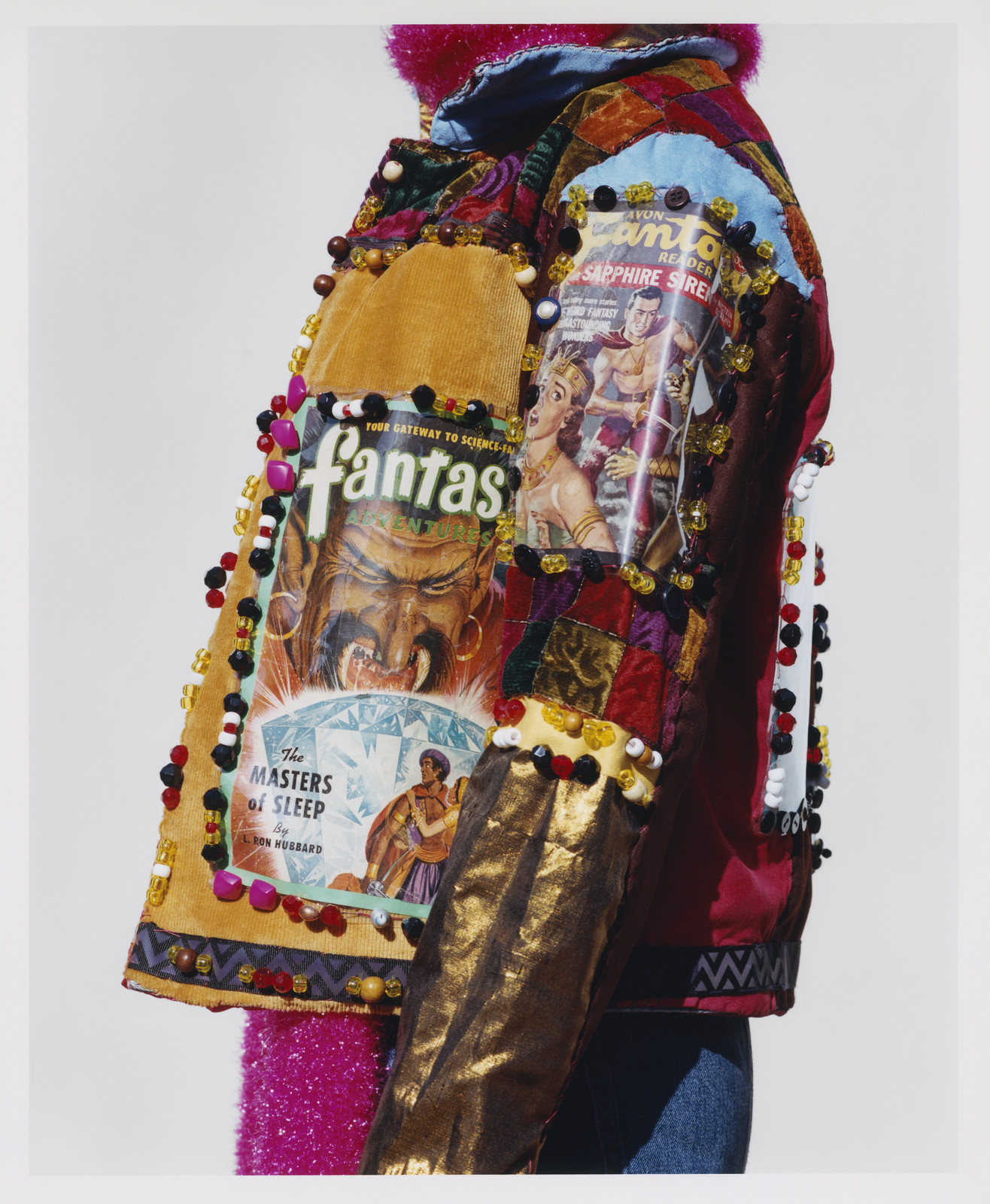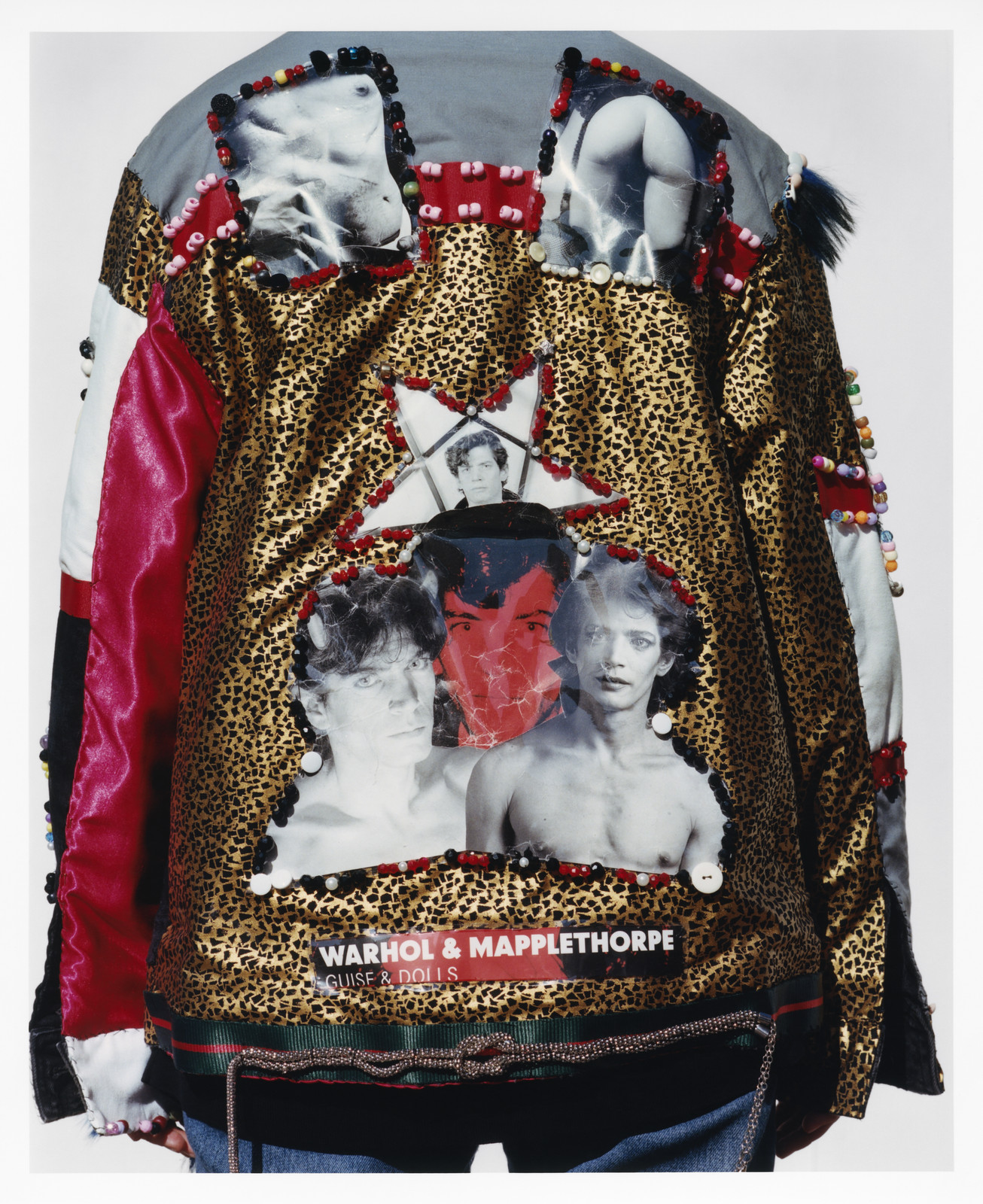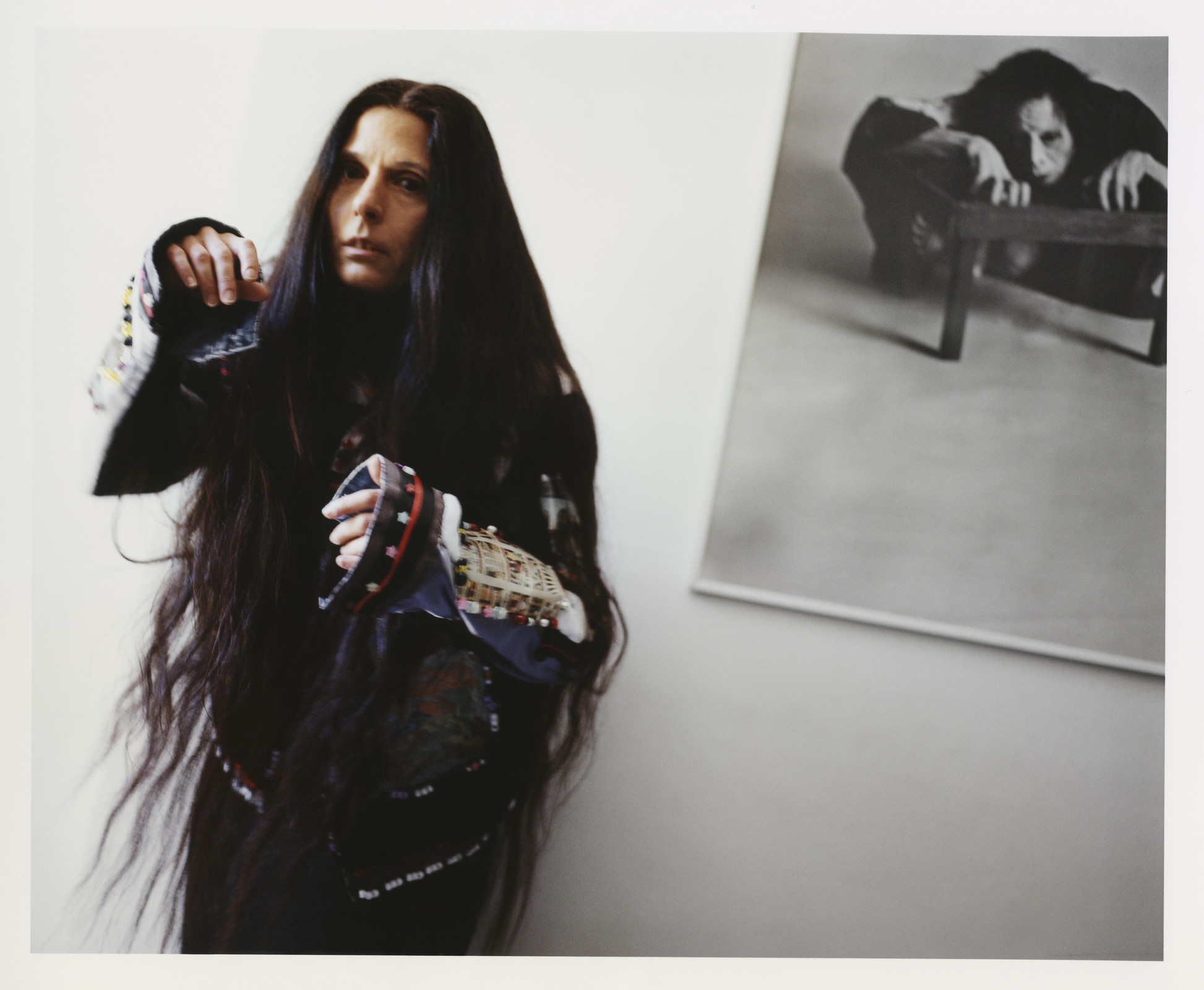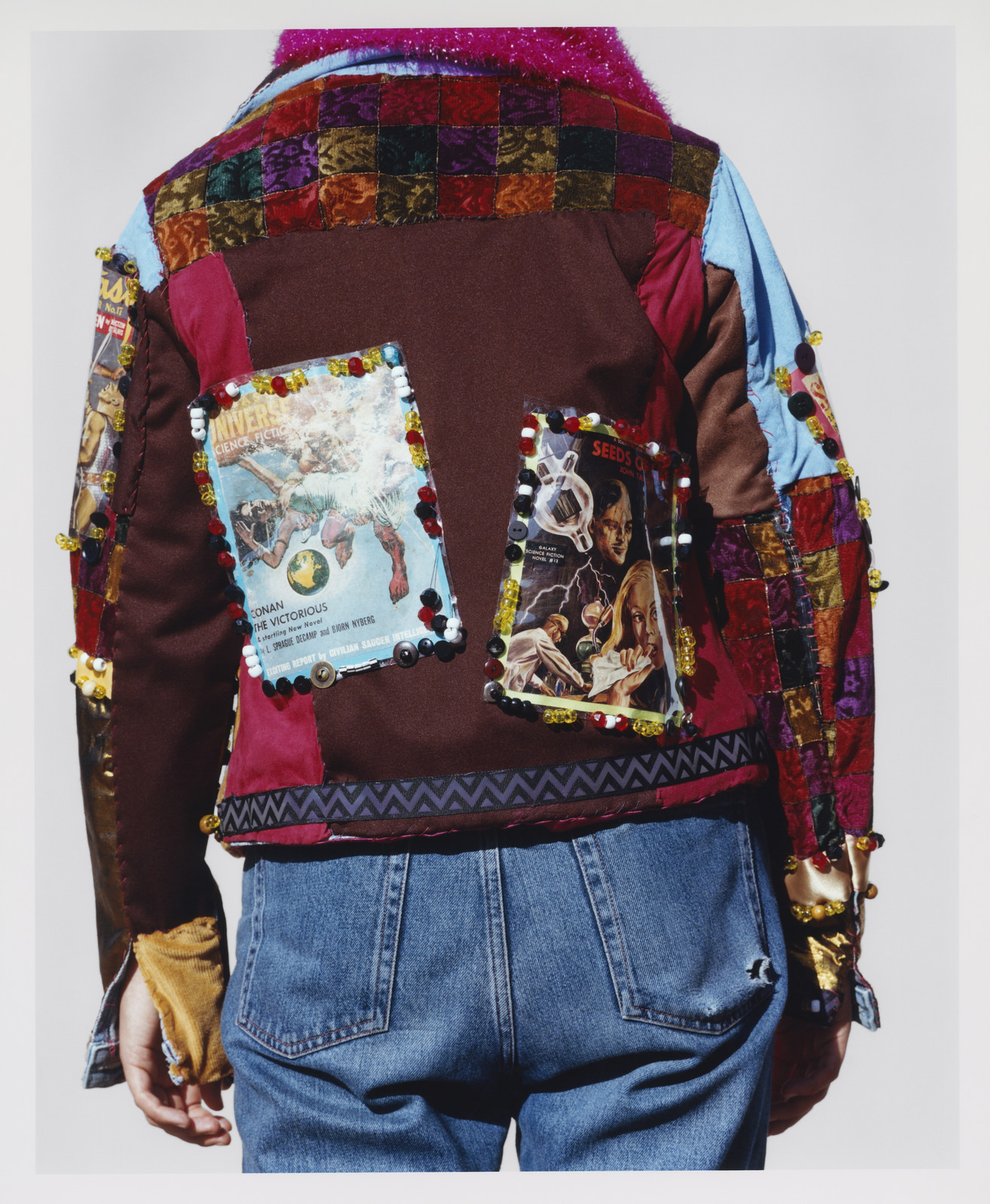Photography by Estelle Hanania
Styling by Ally Macrae
Casting director Emma Matell
Art direction Jeanne Alexandre
Make up Siobhan Furlong
Retouch Upper Studio
Photo assistant Emma Tholot
Performers Meixuan Cheng, Puer Deorum, Ebun Sodipo, Destiny Adeyemi, Rachel Santoro, Dosa Cat, Tyne O’Connell
FULL MENTAL JACKET
Interview by William Van Meter published in More Or Less magazine
Visionary BILL BOWERS has spent his life in the countercultural vanguard. His one-of-a-kind, narrative-driven handmade jackets blend fashion with outsider art
Bill Bowers has lived in San Francisco on and off since 1967. He won’t say his age, not because he’s being demure – he genuinely doesn’t know it. “I stopped counting,” he says. “I was born in ’47. So, sixtysomething? How old am I?” He shed societal norms and constraints long ago.
A rebel through and through, he spent the 1960s and 1970s in communes and as a key member of the DIY genderfuck glam performance renegades the Cockettes, and their avant-garde off-shoot Angels of Light. He made batshit-surreal stagewear for them, as well as influential rockers like Alice Cooper and the Rolling Stones. He now focuses on jackets to express his maximalist aesthetic and freaky vision.
All are deeply personal works and begin as thrift-store Levi’s denim jackets before being deconstructed and rebuilt. (Bowers has never learned how to use a sewing machine and stitches everything by hand.) Each outlandish creation has a dual purpose of clothing and narrative sculpture. He will add his own photographs and all sorts of found and sourced detritus. Some are like sartorial travel scrapbooks and document trips. Other garments have serious themes, such as reflections on Hurricane Katrina, 9/11, and the Jim Crow South. Others delve into more lighthearted inspirations like 1950s sci-fi. Bowers is as colourful as his work; he’s devoted his life to art and made art of his life.
The images in this story feature Bowers’s fabulous jackets on his spiritual offspring, London-based fringe performers and idealists with a similar vagabond creative vision. “I get up in the morning and I make jackets,” he says. ‘I continuously make them and work on three at the same time. I give a lot of them away to friends. It’s better for people to have them on their backs walking down the street than for me to have a closetful.” We had an entrancingly rambling conversation about movie stars, Quaaludes and communes.
Ok, start at close to the beginning.
I graduated high school in Wichita Falls, Texas, 10 miles from the border of Oklahoma on Route 66. It’s really a small town. I didn’t even know that I was gay. I had boyfriends, but we never had sex in Texas. They were all football players. I was a cheerleader for the Hershey Huskies.
I moved to LA with my girlfriend Sharon whose older sister had a Dodge Dart. I didn’t know anything about LA, but we went there and within a month I got a job at this great clothing store called Lenny’s Boot Parlor next to MGM studios. A lot of stars came in. I met Sally Field, Ravi Shankar, Jim Morrison and the Everly Brothers and the little guy who played Timmy from Lassie and his brother named Bill. He was a little older, so I hung out with Bill because he had a car and we ran around.
Lenny’s Boot Parlor sold a lot to MGM. I would deliver the clothes to The Gong Show and The Dating Game. One of the people I worked with there was Michael. He lived with Sal Mineo as his houseboy. Michael became my lover, so I moved in with him and Sal. Sal would have me and Michael go to all the clubs like the Whisky a Go-Go and Pandora’s Box and pick up young boys for him in his limousine. We’d bring them to Sal to play with and then we’d go back out. I was only with Michael for about three months. I never saw or heard from him again.
Tell me about this LA nightlife.
The Whisky a Go-Go didn’t allow dancing. So, they built a stage for about 30 of us Sunset Strip hippies and freaks to dance on for atmosphere for the audience. I was one of Go-go dancers and it got me involved in the rock and roll scene and that went on for close to a year. That’s when I met Sylvester. There was a few Cockettes who lived in LA at that time, Sylvester, Goldie Glitters, Dusty Dawn, and myself. There were so many hippies living in LA that they were congesting Sunset Boulevard on the weekends. The police would arrest us, so we all moved together to San Francisco. I moved all over the place but was back and forth between LA and San Francisco continuously.
I lived in a commune in San Francisco called Muck Manor for about eight years. Most of the Cockettes lived in communes. It was very inexpensive – there was like 15 of us in a three-storey house. We each paid $15 a month. Nobody worked. Right before I left LA, I started making leather chokers and belts. I covered them with snakeskin and studs and I sold them to The Doors’ Jim Morrison’s wife Pamela. She had a store called Lizard on La Cienega Boulevard. I would also buy white loafers and boots and paint them. I also made women’s bags out of those artificial flowers people used to wear. I would make a bag and then cover it in artificial flowers and sell them at this Beverly Hills store.
Were you always crafty?
I went to correspondence art school for about a year, but as soon as I got to LA I stopped that immediately and took LSD and all that stuff, so I never graduated.
Tell me about the jackets.
At that time, antique stores were like the place to buy everything. They were called junk stores then and they were very inexpensive. Now, they’re called vintage and antique stores and they’re very expensive. In the early 1970s, there were junk stores all over the city. I would go around collecting old materials and tchotchkes. When the Cockettes went to New York in ’72 and played the Anderson Theater, where we bombed, I had already made about 10 jackets. On the way there, I went to LA first to sell some jackets to a store that I knew wanted them. The Rolling Stones saw them in the window, it was across the street from their PR Gibson & Stromberg. So, I met them and came up to where they stayed in Hollywood Hills and sold them jackets to Mick and Keith. Rolling Stone magazine wrote it up. With that hype I got a manager, Barbara, she could get her way into anybody’s door. That’s how I got into L’Uomo Vogue. I was selling crazy clothes to Bonwit Teller, Fiorucci and Granny Takes a Trip, thanks to Barbara’s gift of the gab and nerve of death.
Barbara had a store in Boston on Newbury Street called The Caprice. Aerosmith lived next door and they were just hippies. I made clothes for Steven Tyler and all of them and we hung out for about a year. Then I did three Alice Cooper tours. One of my designs was a white leather cape and top hat. And we got white rats, dead ones, from Boston University and we stuffed them and we got dead bats that we lacquered and put them in their mouths and painted blood on the capes. He wore that on his “Nightmare” tour and Salvador Dali did a painting of him in it and stole the cape. For Rose Kennedy’s charity ball, I made Alice Cooper a plastic see-through jacket and pants with 420 dollar bills in it with rhinestones. He went to this fundraiser, but he didn’t give a dime.
You took a long hiatus from making clothes and moved to Florida to concentrate on photography.
There was a monthly magazine called Southern Exposure for gay resorts to give out to their guests. I did the covers, men in swimsuits, all the Gay Pride parades and the leather fairs and anything that’s outside.
People who lived in these communities, we were all connected. Then I hung out with Divine and the John Waters people for six years. After the Cockettes stopped was the Angels of Light, which was way beyond visually. They didn’t believe in charging admission. I worked with them for 10 years.
Tell me about Divine.
She was something else. She ate a lot. She was a big girl and she loved to eat. And she’d eat Quaaludes every day. So did Sylvester – he also took lots of acid when he sang. But there was a whole group of them who lived in Key West when I lived there in the 1970s. Divine’s real name was Glen. She lived here in a commune called Flow Airways a couple doors down from this really huge commune called Hunga Dunga. I met Divine when Pink Flamingos came out because Van Smith, who did her hair and makeup, was a good friend of mine.
Once I went to LA, Three Dog Night had a big party at the Roxy. I went with Divine. We sat at this huge 12ft table and across from us was Cher. I’ll never forget it, Divine read Cher. She had this plate of food in front of her and shoved it across the table towards Cher and said, “I can’t eat this! How dare you wear a tie-dye headband in my presence!” We got up and she said, “Come on, we’re leaving.” She pulled stunts like that all the time. But in person, she was real quiet, real demure. When she wasn’t in drag all she’d wear was white painter’s overalls because she was so big.
Tell me about Florida. Was this like a “wandering in the desert” period? It’s weird you ceased making clothes.
Well, I moved there… You want another truth? I sold drugs, like everyone else did. Well, I guess not everyone, but I did, along with some other people. So, we received all this money from this person in New York who would buy drugs from us and we’d mail them. Well, I was the only person at the house when the money came and I thought, “Ooh, look at all this money!” So, I ended up moving to Florida with that money. That’s how I got to Key West for 10 years. But then one of the friends of the person whose money it was came down there and found me, and I ended up having to pay the money back.
Was that a dangerous situation?
Not really. He’d made so much money off of us anyway, because the chemist who made angel dust was our friend. And the ounces cost us like a $100 they would pay $2,000, and then would make $10,000 off of an ounce. So, he made his money. Then, I didn’t get busted cause I wasn’t there, but I came home and the house had been busted and everybody was in jail. My lawyer told me to get out of Dodge fast.
I’d love to try Quaaludes. Did you enjoy them?
Are you kidding? They were the best drug in the world. That’s why they outlawed them cause it was so good. I guess in like ’75 or ’76 there was this pizza company out here – I don’t know where he got them, I never asked – but he sold jars of hundreds of Quaaludes to certain people and I sold them to dealers for a couple of years. I have a Time article in one of my jackets a friend in Berkeley has. It’s an article on Quaaludes and it has a photograph of a Quaalude jar, and a crescent roll and a glass of orange juice, and it said, “For a fabulous day, take one of each.” They started making little necklaces and earrings out of fake Quaaludes.
They became so popular and people were drowning and dying, falling out of buildings and things like that.
So, you live in San Francisco now, what is that like it’s such a different place than when you first arrived.
I have really inexpensive rent because I’m HIV positive. I have a two-bedroom for $185 a month, plus I have a roommate, so all I pay really is $90. That’s the only way that I can afford today to make these jackets because my rent is so cheap. I get like $1,000 a month through my social-security cheque. It leaves me with enough to buy materials and things that I need.
